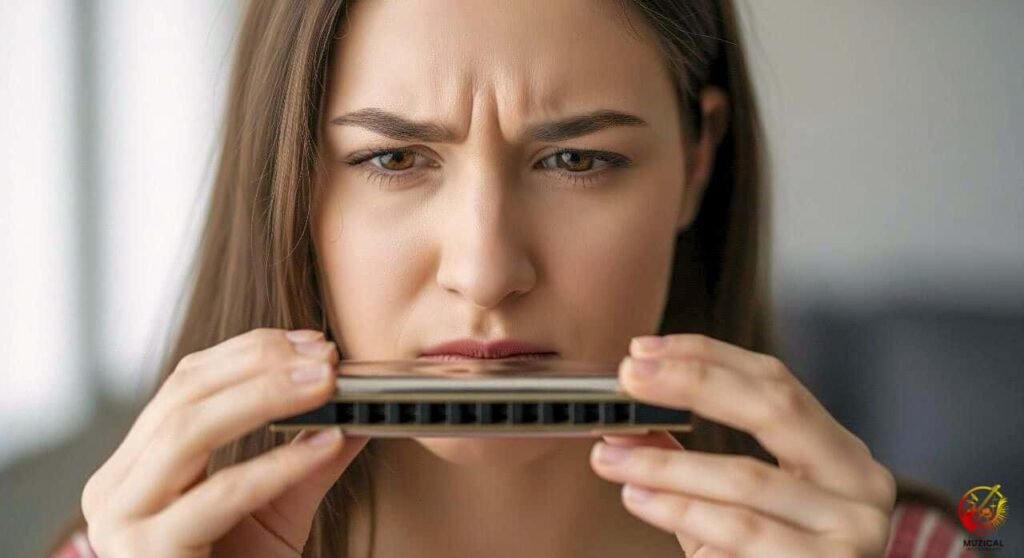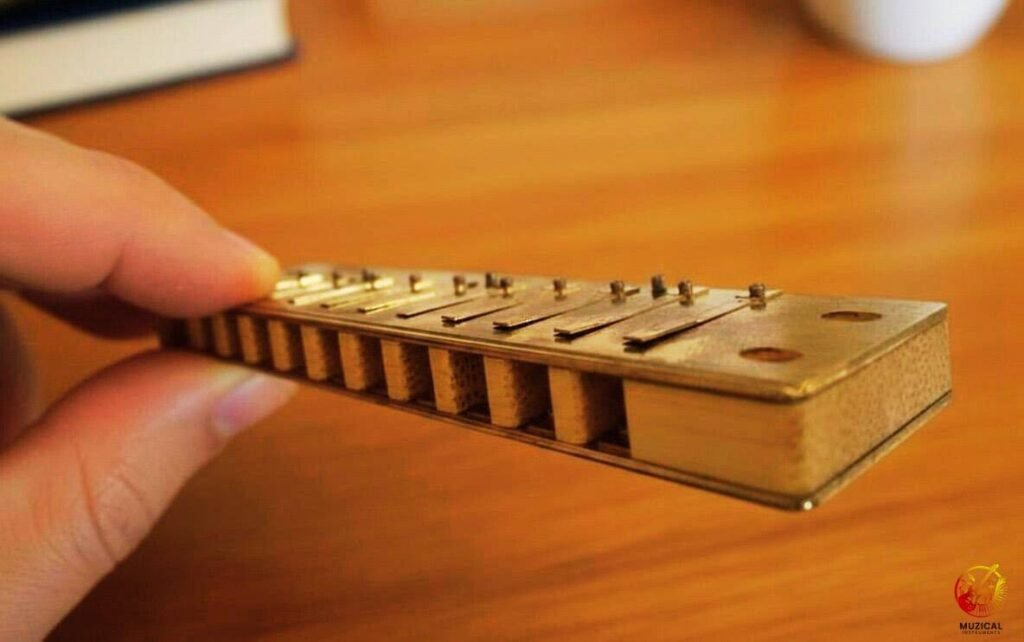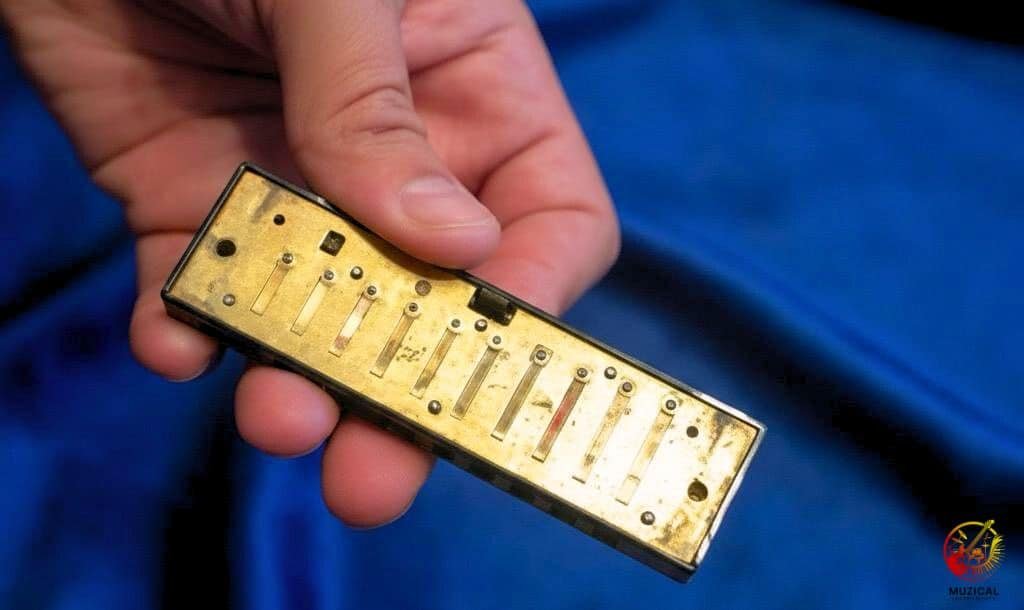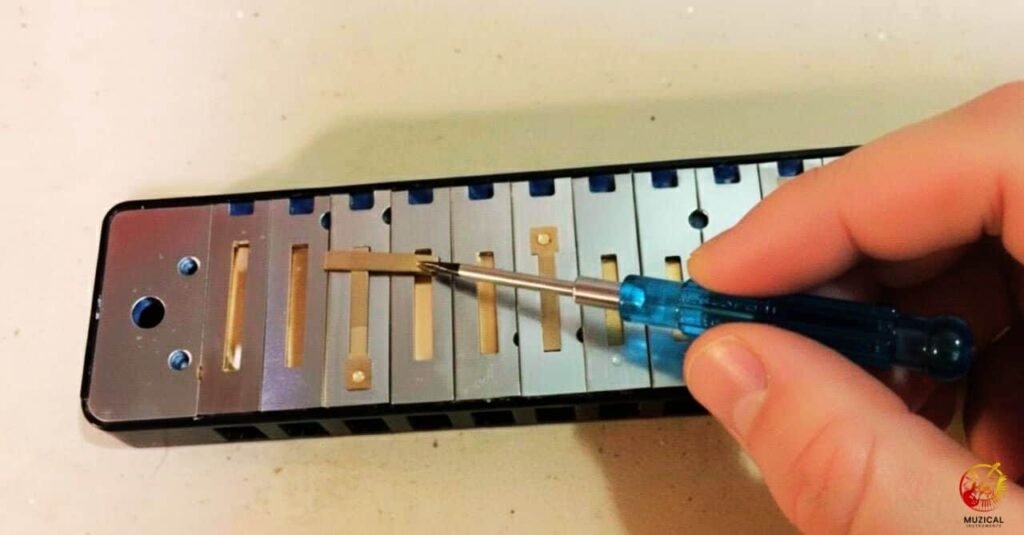Blocked Reeds on Harmonica: Easy Troubleshooting Tips
Nothing stops a good jam session faster than blocked reeds on harmonica. One second you’re playing your heart out, the next, a note just vanishes.
It’s a super common issue that happens to every player, whether you’re a pro or just starting out. That dead spot where a note should be isn’t usually a broken harp, it’s just a stuck reed.
Reed blockages happen when stuff gets stuck around the metal strips that make sound inside your harmonica. Dust, food bits, dried spit they all mess with how those thin metal pieces vibrate. When reeds can’t move freely, your notes suffer.
You’ll discover what causes these annoying blockages, learn simple cleaning tricks that actually work, and pick up smart habits that keep your blues harp singing sweetly.
We’ll also cover when to fix versus replace, plus money-saving maintenance tips that extend your instrument’s life.
What Makes Harmonica Reeds Get Stuck?

Your biggest enemy is everyday debris that sneaks into reed chambers. Pocket lint, food crumbs, and dust particles love hiding in those tiny spaces where reeds vibrate. Play after lunch? Those sandwich crumbs follow your breath straight into the reed plates.
Saliva creates sticky messes inside harmonicas. Everyone drools a little while playing, it’s normal. But that moisture picks up bacteria and food particles, creating gummy buildup around reed slots. Marine Band players know this struggle well, especially with wooden combs that absorb moisture.
Brand new harmonicas sometimes have factory debris blocking reeds right out of the box. Hohner, Seydel, and other manufacturers occasionally miss tiny metal shavings or leftover assembly wax. That’s why new chromatic harmonicas might have dead notes before you’ve played them once.
Weather changes mess with reed clearances too. Cold makes metal contract while heat expands it. Your Special 20 might play perfectly indoors but struggle outside during winter gigs. Humidity from summer festivals can make reeds stick or corrode faster than usual.
Quick Fix: Tap your harmonica gently against your palm while playing each hole. Sometimes loose debris just needs encouragement to fall out.
How Do You Spot Blocked Reeds on Harmonica?

Dead holes are obvious, you blow or draw and get silence instead of music. But partial blockages are sneaky. That weak 6 draw that used to scream now whimpers. Your 2 draw bend feels mushy instead of crisp.
Test every hole individually. Play single notes across your entire diatonic harmonica, listening for volume differences. Healthy reeds respond quickly and ring clearly. Blocked ones sound airy, take extra breath pressure, or cut out randomly while you’re playing.
Look through each hole with bright light behind the harmonica. You should see clear gaps around every reed. Visible junk, discoloration, or reeds touching their slots spell trouble. Sometimes you’ll spot the exact piece of debris causing problems.
Feel matters too. Blocked holes often fight your air pressure. Instead of smooth, easy response, you’ll notice resistance or stuttering when breathing through affected chambers.
| Problem | What You Hear | What It Means |
|---|---|---|
| Dead silence | Nothing at all | Complete blockage |
| Weak sound | Breathy, thin tone | Partial obstruction |
| Stuttering | On-off response | Loose debris |
| Extra effort | Need more breath | Minor blockage |
What’s the Easiest Way to Clear Blocked Harmonica Reeds?

Start with warm water, your gentlest weapon against blockages. Remove cover plates carefully, then rinse reed plates under lukewarm tap water. Gently shake while rinsing to help stuck particles break free. This simple step fixes most loose debris problems.
Soft toothbrushes work great for stubborn gunk. Brush very lightly along the reed’s natural movement direction, never against it. Old electric toothbrush heads are perfect, soft bristles won’t damage delicate reed tips. Focus on areas around reed slots where sticky buildup loves hiding.
Canned air blasts away dry particles effectively. Use short bursts from different angles, avoiding excessive pressure that might bend reeds. Computer keyboard cleaners or camera lens blowers work perfectly for this job.
Sticky residue needs soaking power. Mix warm water with one drop of dish soap, then briefly soak the reed plates. Gentle brushing after soaking removes most stubborn buildup. Always rinse thoroughly and dry completely before reassembly.
Pro Tip: Never use sharp objects like needles or paper clips. They’ll scratch reed plates or bend reed tips, creating bigger problems than you started with.
Can You Fix Blocked Reeds Without Taking Apart Your Harmonica?
Several tricks work without dismantling your mouth harp. Try the palm tap method first hold your harmonica firmly and tap it against your palm while playing the blocked holes. Vibration often shakes loose particles free.
The blow draw technique uses air pressure changes to clear blockages. Play rapid back and forth breathing on affected holes, gradually increasing air pressure. This method works especially well for dust or lint caught near reed surfaces.
Gravity helps too. Hold your chromatic or diatonic harmonica vertically with blocked holes pointing down. Play those holes while gently shaking the instrument. Particles often fall out through bottom openings.
Warm breath moisture can soften dried buildup enough for removal. Cup the harmonica in your hands and breathe humid air into blocked holes for 30 seconds. Then immediately play those holes firmly to blast loose the softened debris.
These external methods have limits though. Deep blockages, manufacturing debris, or heavy crud buildup usually need proper disassembly and cleaning.
When Should You Replace Blocked Reeds Instead of Cleaning Them?

Cracked or chipped reeds need replacement, not cleaning. After clearing blockages, inspect each reed under good light. Damaged reed tips can’t vibrate properly no matter how clean they are. Professional repair shops like Joe Filisko’s or Brendan Power’s can assess damage accurately.
Cost matters when deciding repair versus replacement. Reed replacement runs $15-30 per reed through harmonica techs. Compare that to new instrument prices, a new Special 20 costs around $40, while custom work on vintage Marine Bands might hit $100+.
Consider your harmonica’s overall condition. Multiple blocked reeds plus worn covers, corroded screws, or cracked combs suggest replacement makes more sense. But vintage instruments or high end models like Seydel 1847s often justify professional restoration.
Playing frequency influences replacement timing too. Daily players wear out harmonicas faster than weekend warriors. If you gig regularly, keep backup instruments ready while getting repairs done.
| Repair Cost | New Harmonica | Best Choice |
|---|---|---|
| $15-30 single reed | $30-50 student model | Replace instrument |
| $50+ multiple reeds | $40-70 mid-range | Replace instrument |
| $75+ full service | $100+ professional | Consider repair |
How Can You Prevent Future Reed Problems?
Clean your harmonicas regularly before blockages develop. Rinse with warm water after every 4-5 playing sessions to remove moisture and loose particles. This simple habit prevents most blocked reeds on harmonica from happening.
Practice good mouth hygiene to reduce contamination. Wait 30 minutes after eating before playing, and rinse your mouth with water to clear food debris. Keep practice harmonicas separate from performance instruments if you’re serious about preventing problems.
Store instruments properly in protective cases that allow air circulation. Avoid humid places like bathrooms or car trunks where condensation promotes corrosion and sticky buildup. Hohner cases or custom wooden boxes work great for valuable harmonicas.
Monitor playing environments. Dusty venues, outdoor festivals, and workshop settings create higher risk for debris problems. Consider protective covers between songs in challenging conditions.
Control moisture through proper technique and drying procedures. Let harmonicas air-dry completely between sessions by leaving them case-open in well-ventilated areas. Desiccant packets help in humid climates.
Smart Move: Keep a practice log noting which holes develop problems most often. Patterns reveal environmental factors or playing habits that cause recurring blockages.
Final Thoughts
Blocked reeds on harmonica don’t have to ruin your music. Most problems respond well to gentle cleaning with water, soft brushes, and compressed air. The secret is catching blockages early before loose debris becomes stubborn buildup.
Prevention beats repair every time. Regular cleaning, smart storage, and good mouth hygiene stop most reed problems before they start. When cleaning fails, knowing repair versus replacement costs helps you make smart money decisions about your instruments.
Start checking and cleaning your harmonicas today. Your future self will thank you when every bend, draw, and blow rings clear and strong, exactly when the music demands it most.
FAQ: Blocked Reeds on Harmonica
1. Why is a note on my brand new harmonica already not working?
This is frustrating, but it can happen. Sometimes, a tiny particle from the manufacturing process can get lodged in a reed slot. It can also happen if the harmonica was bumped or dropped during shipping, causing a reed to become slightly misaligned. Before returning it, try the simple fix: hold the harmonica with the holes facing down and tap it firmly but gently into the palm of your hand. This often dislodges the debris and solves the problem instantly.
2. Can I clean my harmonica with just water?
You need to be very careful with water. If your harmonica has a plastic or sealed alloy comb, you can safely wash the comb and metal cover plates with warm water and a little soap. However, you should never soak a harmonica with a wooden comb, as the wood will swell, warp, and crack. For the metal reed plates, it’s better to use a soft brush and a cotton swab with a small amount of 70% isopropyl alcohol, which cleans effectively and evaporates quickly to prevent rust. Always make sure every part is completely dry before reassembling.
3. How often should I deep clean my harmonica?
There’s no single magic number, as it depends on how much you play. For daily maintenance, you should always tap out excess moisture after each session. For a full deep clean (taking the instrument apart), a casual player might do it once or twice a year. If you play for an hour or more every day, you might want to do a full cleaning every 1-3 months. A good rule of thumb is to clean it whenever you feel its responsiveness start to decrease.
4. How can I tell if a reed is stuck or actually broken?
This is a key difference. A stuck reed is usually completely silent or sounds choked because something is physically blocking it from moving. A broken reed has a hairline crack in the metal from fatigue. It will often still make a sound, but it will be very flat and won’t hold its pitch, especially when you play it hard. The only way to know for sure is to take the harmonica apart and look at the reed. A stuck reed will look fine once cleared, while a broken one will have a visible fracture near its base.
5. Can blowing too hard damage my harmonica’s reeds?
Yes, absolutely. This is one of the most common ways players wear out their harmonicas prematurely. The reeds are designed to vibrate efficiently with controlled breath. Constantly playing with excessive force puts a huge amount of stress on the metal, leading to fatigue. This causes the reeds to go flat over time and eventually break. Playing with good breath control not only sounds better but also makes your harmonicas last much longer.
6. Why does my harmonica note sound buzzy instead of just silent?
A buzzing or rattling sound is a classic sign of a reed that is just barely touching something it shouldn’t be. This could be a tiny piece of lint caught on the edge of the reed, or it could be a misaligned reed that is brushing against the side of its slot as it vibrates. The fix is the same as for a fully blocked reed: take the harmonica apart, thoroughly clean the reed and slot, and check to ensure the reed is perfectly centered.
7. What does “gapping” a harmonica reed mean?
Gapping is the process of adjusting the height of the reed’s tip away from the reed plate. The size of this gap affects how the harmonica plays. A smaller gap makes the reed respond to very little breath, making it easier to play softly and perform overblows. However, it might choke if you play too hard. A wider gap requires more breath to activate the reed but can handle more aggressive playing without choking. Gapping is a more advanced technique used by players to customize a harmonica to their specific playing style.
